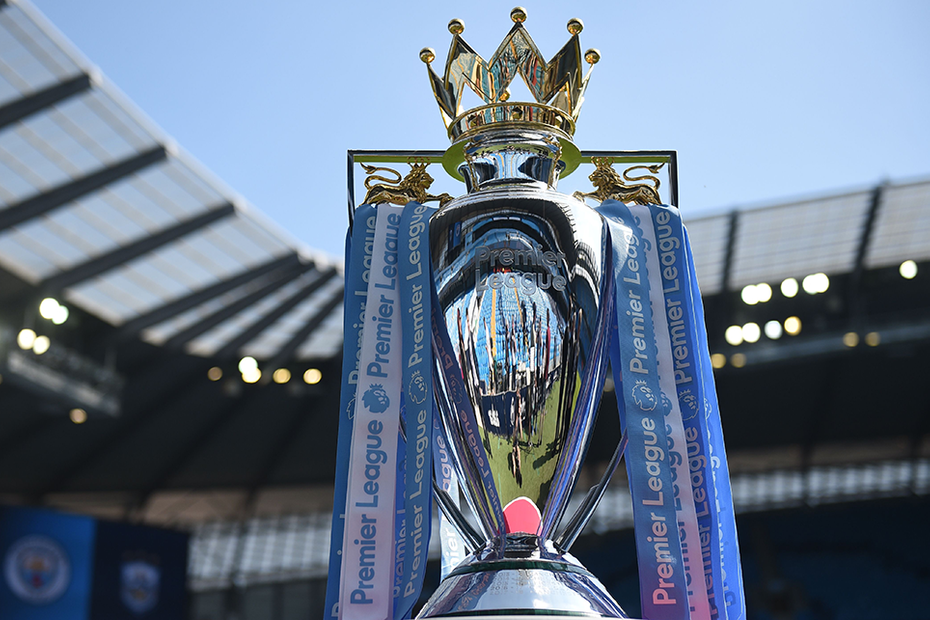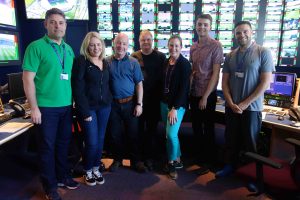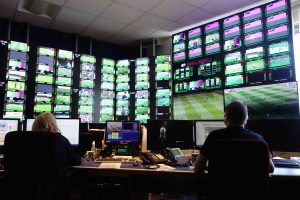Inside BT Tower network hub for final day of the Premier League season
 Manchester City finally edged out Liverpool to claim the Premier League title on Sunday 12 May. The football drama ensured the busiest day of the season for the team in BT Tower in central London, due to strong demand for Premier League coverage from broadcasters worldwide and the fact that all ten games took place simultaneously.
Manchester City finally edged out Liverpool to claim the Premier League title on Sunday 12 May. The football drama ensured the busiest day of the season for the team in BT Tower in central London, due to strong demand for Premier League coverage from broadcasters worldwide and the fact that all ten games took place simultaneously.
On a normal weekend matches are played across Friday evenings (sometimes), several start times on Saturdays and Sundays, and a Monday night match.
However, every match was in play that afternoon, all kicking off at 15:00. BT’s network is more than scaled to take on the challenge of transporting feeds from 10 Premier League grounds simultaneously, but it requires a much more intense level of monitoring and the ability to be able to react quickly to any potential problems.
“Feeds from here are being sent all around the world. Imagine BT Tower as a big telephone exchange, but for video. We make all those connections.”
Also, the network connectivity between BT Tower and the broadcaster’s production facilities are running hot, as these lines are optimised for an average day’s demand, so on this day, almost every single line is in use simultaneously.
Every single monitoring square on the video wall in the Ops Master Control Room at BT Tower had a live feed coming through on 12 May.

In the MCR at BT Tower on Sunday 12 May: (L/R) Nick Preston, team leader TVOB MCR; Stephanie Smith, TVOB MCR; Kevin Gooding, TVOB MCR; Paul Marsh, TVOB MCR; Kate Wendelboe, director, BT Media & Broadcast; Callum Elsdon, Global Occasional Use business development; and Lee Davies, TVOB MCR Switching
The team have direct lines from BT Tower to the master control room at IMG Studios Premier League Productions facility in Stockley Park near Heathrow and to Sky’s facilities at Osterley Park – meaning that if a problem arose, they could immediately connect to their counterparts and agree how best to shift the lines around between BT Tower and the customer’s facilities to ensure the most valuable feeds were restored/maintained.
For the last day of the season, BT brought around 130 uncompressed HD vision feeds back from venues to the Tower, split across multiple customers. These included clean feeds, multiple camera angles, interview lines and unilaterals. They also sent multiple reverse HD feeds back to venues.
On top of that were at least 10 UHD services compressed as visually lossless TICO and several return UHD feeds. They carried around 20 4-wire circuits and 15Gbit/s of data and internet services from across the venues.
Feeds were switched on the network through two switching hubs direct to BT’s broadcaster customers. They had the ability where requested to multicast services to the FacilityLine vision matrix at BT Tower for other takers. There was also multiviewer capability at customer premises that were remotely managed from BT Tower with return monitoring feeds back to the OB MCR and on to the wall displays. This meant they could see services right from venue to customer handoff.
In terms of the capacity of the network from each of the grounds, there was 80Gbit/s per venue across two fibre routes, so 40Gbit/s plus 40Gbit/s per venue. Delivery of content was predominantly over fibre but the TVOB fleet has satellite and microwave capability too, if any additional capacity or additional diversity/resilience is required.
English Premier League all around the world
Media & Broadcast’s main customers are IMG’s Premier League Productions (PLP), BT Sport and Sky Sports. The latter are the UK broadcast rights holders while PLP produces content for 80 broadcasters in 212 territories worldwide. An average game is watched by over 12 million people.
BT Media & Broadcast director Kate Wendelboe told SVG Europe, “It isn’t necessarily the team’s busiest day of the year; but it’s the busiest couple of hours because everything’s happening simultaneously. They’ve got all the clean and dirty feeds, data, and voice services. And what we’re finding year on year is that the number of visions is increasing and we’re seeing quite a bit of growth in the data area and some of the UHD aspects. All the lines are maxed out during this two-hour window today.
“Media & Broadcast is a market-facing unit that sits within the Enterprise division of BT,” she said. “We have Enterprise, Global Services and Consumer. BT TV and BT Sport sit in the Consumer division. We’re the media services provider arm, and then we’re all supported underneath by a technology organisation. The guys in our OB MCR room here in the Tower come from that organisation.”
Callum Elsdon, Global Occasional Use business development for BT Media & Broadcast said, “every one of these screens has got some content going through it. The majority of this is done for Premier League Productions. One of the matches has 24 visions out of the stadium today. Obviously, if something in the network were to go down, then the majority of the world would not be able to see their Premier League content.
“At each of the Premier League sites, there is a remotely-managed cabinet with our 40+40 Gig fibres, where the customer can patch into the cabinet themselves. Some customers choose to have one of our engineers on site to support them as well. These guys in here can then monitor what’s going on in those cabinets, looking at the connectivity, and they can remotely open and close it without the need for any manual intervention.
“All of the content for Premier League Productions goes from the grounds to IMG Studios in Stockley Park. It’s uncompressed for HD and for UHD we use TICO. This is as well as work completed for the other host broadcasters, BT Sport and Sky Sports.”
“We also have horse racing going through today,” added Wendelboe, “plus the BAFTAs tonight — which is over microwave rather than fibre, as there is line of sight to the Tower. With all of these customer relationships, it’s about developing the network with their requirements in mind. We need to really understand what they want and need, in order to build the best network.”
A giant telephone exchange – for video
TVOB Master Control Room team leader Nick Preston told SVG Europe, “There are two UHD feeds today for Sky Sports, who are doing the Man City and Liverpool games. They’ve got links between the two, so depending on who wins they can have pictures back and forth. We have Scottish football going through today as well, on top of the racing and the BAFTAs. We’ve also got tennis from Madrid as well.
“What we’ve got up today would normally be across Saturday, Sunday and Monday night, and maybe  Friday as well. Sunday is normally Sky Sports, doing what they call hub and slave games – with the late game being the hub and one or two slave games earlier in the day. We provide all the network links between venues via here. BT Sport will bookend it with an early or late game, or two games on Saturday – and they have a slightly different configuration to how Sky runs.
Friday as well. Sunday is normally Sky Sports, doing what they call hub and slave games – with the late game being the hub and one or two slave games earlier in the day. We provide all the network links between venues via here. BT Sport will bookend it with an early or late game, or two games on Saturday – and they have a slightly different configuration to how Sky runs.
“It’s a combination of unmanned cabinet work and BT trucks connected to the cabinets to provide other services,” said Preston. “Racing is all unmanned again through cabinets, managed from here.
“Today is challenging because of the sheer volume: I think 195 visions in total, at last count.
“We’re a mirror for Stockley Park in terms of circuits: but what we’re doing today is breaking out a lot of services to feed their onward customers,” he said. “So we’re an overflow, a backup to some of the services and general management of the whole network, plus all third party distribution to international customers.
“Feeds from here are being sent all around the world. Imagine BT Tower as a big telephone exchange, but for video. We make all those connections.”

